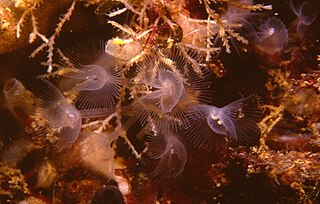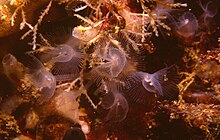
Balanoglossus is an ocean-dwelling acorn worm (Enteropneusta) genus of zoological importance because, being a Hemichordate, it is an "evolutionary link" between invertebrates and vertebrates. Balanoglossus is a deuterostome, and resembles the Ascidians or sea squirts, in that it possesses branchial openings, or "gill slits". It has a notochord in the upper part of the body and has no nerve chord. It does have a stomochord, however, which is a gut chord within the collar. Their heads may be as small as per 2.5 mm (1/10 in) or as large as 5 mm (1/5 in).

Phoronis is one of the two genera of the horseshoe worm family (Phoronidae), in the phylum Phoronida. The body has two sections, each with its own coelom. There is a specialist feeding structure, the lophophore, which is an extension of the wall of the coelom and is surrounded by tentacles. The gut is U-shaped. The diagnostic feature that distinguishes this genus is the lack of epidermal invagination at the base of the lophophore. These worms are filter feeders. They live on hard substrates or soft sediments in marine environments throughout the world. They have different modes of reproduction which help with their success.

Phoronids are a small phylum of marine animals that filter-feed with a lophophore, and build upright tubes of chitin to support and protect their soft bodies. They live in most of the oceans and seas, including the Arctic Ocean but excluding the Antarctic Ocean, and between the intertidal zone and about 400 meters down. Most adult phoronids are 2 cm long and about 1.5 mm wide, although the largest are 50 cm long.

Merica is a genus of sea snails, marine gastropod mollusks in the family Cancellariidae, the nutmeg snails.
Phoronopsis is a genus of horseshoe worm in the family Phoronidae, in the phylum Phoronida. The members of the genus live in tubes at the bottom of the sea.
Phoronis psammophila is a species of marine horseshoe worm in the phylum Phoronida. It lives in a tube projecting from the sea floor in shallow seas around the world.
Phoronopsis californica is a species of marine horseshoe worm in the phylum Phoronida. It was first described as a new species by William Hilton in 1930 when he found it at Balboa Bay in Newport Beach, California.

Sagartia is a genus of sea anemones in the family Sagartiidae. The genus was first described by Philip Henry Gosse in 1855 and the image is his painting of several species found in British waters included in his book, A history of the British sea-anemones and corals.

Cerianthus membranaceus, the cylinder anemone or coloured tube anemone, is a species of large, tube-dwelling anemone in the family Cerianthidae. It is native to the Mediterranean Sea and adjoining parts of the northeastern Atlantic Ocean.

Phoronis australis is a species of marine horseshoe worm in the phylum Phoronida. It is found in shallow warm-temperate and tropical waters in the eastern Atlantic Ocean and the Indo-Pacific region and was first detected in the Mediterranean Sea in the late twentieth century. These worms live in association with tube-dwelling anemones, particularly those in the genus Cerianthus.
Phoronis ovalis is a species of marine horseshoe worm in the phylum Phoronida. It is found in shallow waters in the northeastern Atlantic Ocean, the southeastern Atlantic Ocean, Argentina, and other scattered locations worldwide. These worms secrete a tube into which they can retreat, and burrow into the shells of molluscs.
Phoronis may also refer to:
Phoronis embryolabi is a species of marine horseshoe worm in the phylum Phoronida. It is found in Vostok Bay, where it lives together with Nihonotrypaea japonica, an Axiidea shrimp species, in its burrows.
Phoronis emigi is a species of marine horseshoe worm in the phylum Phoronida. It is found off the coast of Japan and is morphologically similar to Phoronis psammophila.
Phoronis ijimai is a species of marine horseshoe worm in the phylum Phoronida.
Phoronis muelleri is a species of marine horseshoe worm in the phylum Phoronida.
Phoronis pallida is a species of marine horseshoe worm in the phylum Phoronida.
Phoronis savinkini is a species of marine horseshoe worm in the phylum Phoronida. It is found in the Gulf of Tonkin. The holotype was collected off the coast of Vân Đồn District, Quang Ninh Province in northern Vietnam.
Phoronopsis harmeri is a species of marine horseshoe worm in the phylum Phoronida. It was first described by H.L.M. Pixell in 1912, and was found off of Vancouver Island.
Phoronopsis albomaculata is a species of marine horseshoe worm in the phylum Phoronida.







